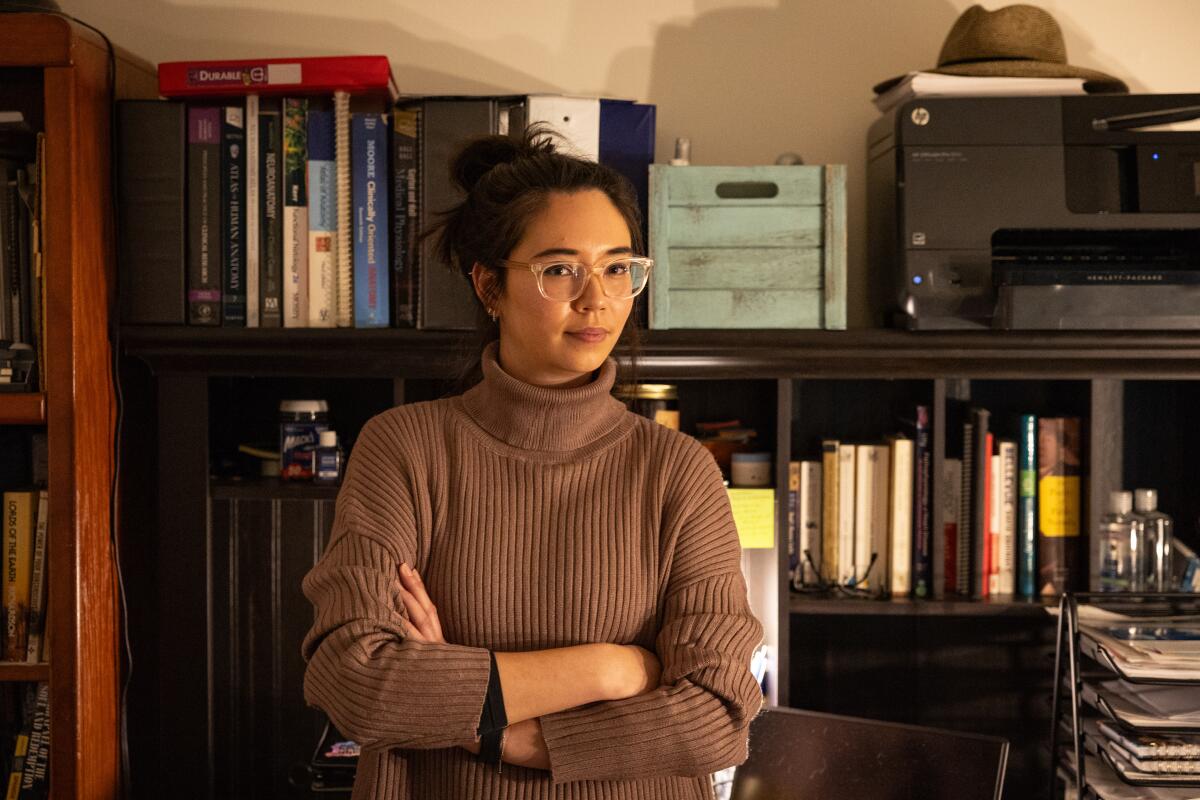In her Glendale home as the evening approached, Dara Bruce fed her pet rats George and Fred, poured herself a glass of water, and dialed a stranger to discuss the presence of a dangerous virus in his blood. “Is now a good time to talk?” she asked. Bruce is a volunteer in the ongoing battle against hepatitis C. The elusive virus claims around 14,000 lives each year in the United States, even though it can be easily cured with a few months of medication. Many individuals are unaware that they are infected, going for years without symptoms before the blood-borne virus severely damages the liver. However, public funding to fight hepatitis C is so limited that in Los Angeles County, the essential task of contacting those who are infected is carried out by unpaid volunteers like Bruce through a new initiative called Project Connect. A collaboration between USC and the county public health department, Project Connect trains volunteers to reach out to individuals who have tested positive for the virus to ensure they are aware of their results and to encourage them to seek the necessary medication. Sitting at her desk surrounded by anatomy textbooks, relics from her master’s degree in integrative anatomical sciences, Bruce confirmed that she had the right person before delivering the news. His reaction lifted her spirits. “Oh, beautiful!” she exclaimed after the man informed her that he had been treated. “I love to hear that.” Such responses are rare. Among those contacted by Project Connect, less than a third had received treatment as of mid-January. This mirrors the alarming statistics across the U.S., where only about a third of people who test positive begin treatment within a year. The number of new hepatitis C infections reported annually more than doubled between 2014 and 2021, exceeding 5,000. In the same year, over 107,000 long-term infections were newly identified, according to federal data. Certain untreated infections may resolve on their own, but many will persist, leaving individuals vulnerable to illness and death. Individuals with long-term infections may develop cancer or end up with severe liver scarring necessitating an organ transplant. Experts attribute the high number of untreated patients to barriers such as doctors unnecessarily referring patients to specialists, and insurers making it challenging to obtain the costly medication, which can exceed $20,000. Many individuals are unaware that they are infected: One in six people contacted by Project Connect volunteers were unaware of their test results. The virus has disproportionately affected individuals who are often disconnected from health systems, including those who inject drugs or are homeless. Many at-risk individuals are unaware of the threat, including baby boomers who were infected long before the virus was identified. Merely having an effective hepatitis C medication available isn’t sufficient to address the issue, remarked Dr. Jeffrey Klausner, an infectious disease specialist at USC. It is crucial to reach the patients who require it. “You need people to be aware of their infection. You need people to be seen by a treating provider. You need people to get the medications prescribed,” he stated. Dr. Prabhu Gounder, medical director of the viral hepatitis unit at the L.A. County Department of Public Health, emphasized that “this is a disease without resources.” This sentiment is echoed across the country. In a national survey conducted by hepatitis organizations, only 3% of local jurisdictions stated that they could make progress toward hepatitis elimination goals with the current level of federal funding. “It’s incredibly dangerously underfunded,” remarked Anne Donnelly, a member of the California Hepatitis Alliance working with the San Francisco AIDS Foundation. The Biden administration has been advocating for billions of dollars to eradicate hepatitis C, arguing that the investment would yield long-term benefits as Medicaid recipients avoid expensive care for liver ailments. An analysis by the National Bureau of Economic Research revealed that the initiative would save the federal government over $13 billion over a decade, surpassing its initial costs. “Nobody in public health is unaware of ‘what needs to be done to address hepatitis C,’” stated Sonia Canzater, associate director of the Infectious Diseases Initiative at Georgetown’s O’Neill Institute for National and Global Health Law. “The problem has always been the resourcing and getting the political and the social will behind it.” In Los Angeles, Gounder mentioned that budget constraints have made it unfeasible to implement an extensive program for individuals with hepatitis C. However, “what if we were to just give them a call and make sure that they’re aware of their infection? Provide some education?” Gounder pondered. “That alone is not going to solve this epidemic. But we thought that was a low-resource thing that we could do to try to move the needle.” The result was Project Connect. Launched in April, the initiative assigns volunteers with reaching out to approximately 3,000 county residents and is now adding another 3,000 cases to its list. Klausner asserted that the project relies on the part-time efforts of five university staffers and anywhere from six to 12 student volunteers, many of whom require field experience hours for their public health graduate degrees. The public health department educated them on patient privacy regulations as well as fundamentals on the virus and its treatment. The USC volunteers currently dedicate a minimum of four hours each week to calling and texting individuals about their test results using reports provided by the county after patients test positive. Learning about the ongoing toll of the virus “fired me up,” stated Bruce, a 36-year-old former aerial arts performer. Her interactions with hepatitis C patients led her to realize “how prevalent it seemed to be across people from all different walks of life,” but also the significant disparities in how individuals were affected after learning about their infections. “There were such different stories.” Some individuals expressed a desire for treatment but had no means to reach a doctor or couldn’t take time off work. Other patients lacked a sense of urgency to obtain the medication, as it can take years for severe health issues to manifest. For them, it “just didn’t really seem like something they needed to get taken care of right now,” Bruce commented. Over 70% of the patients on volunteers’ lists cannot be contacted, often because the phone numbers in their records were incorrect. The team lacks the resources to track down individuals in government databases or on the streets, as public health departments do for some other illnesses. L.A. County’s public health department is not allocating any of its own funds to Project Connect, relying solely on the USC volunteers and some support from county employees. Gounder estimated that hiring a small team to tackle such work would cost approximately $250,000, a figure that “is not feasible with the budget we have.” His viral hepatitis team receives approximately $1.2 million in grant funding from the federal Centers for Disease Control and Prevention and the California Department of Public Health, but this must cover expenses for hepatitis A and B along with C. In comparison, the county receives roughly $97 million in state and federal grants to address HIV. Gounder remarked that funding for hepatitis C has been so limited that he cannot determine the exact number of cases in the county, but state estimates suggest it matches or exceeds the number of HIV cases. Both diseases can be fatal and pose risks of infection if left untreated. The drive to provide antiretroviral treatment to HIV patients was supported by “an incredibly active community” that included affluent individuals, noted Dana Goldman, dean of the USC Sol Price School of Public Policy. A similar mobilization has not occurred for patients with hepatitis C, but “that doesn’t mean they’re any less deserving,” he stated. Relying on volunteers has its limitations: Among other things, it means the work may be interrupted during university breaks or exam periods, said Klausner. Moreover, phone calls alone have their limitations: Among the untreated patients Project Connect followed up with after three months, only 20% had received the medication. Klausner believes the county has an obligation to fund paid staff. He wants the outreach teams to be able to schedule individuals for treatment and assist them with transportation vouchers, child care, or other aid – the “linkage to care” that has been lacking. However, Bruce asserted that even a phone call can be meaningful for the individuals on the other end of the line. “This is about listening to people and their stories,” she remarked. In her Glendale apartment, Bruce inquired if the man on the phone had time for a few more questions. The responses would help officials gain a clearer understanding of who is receiving treatment and who is not. “I’m glad you’re a success story for treatment,” she expressed before bidding him good night. Bruce made another call, only to be hung up on. She called again and left a message with her phone number.
Unpaid Volunteers Key in Los Angeles’ Fight Against Hepatitis C













